Photo: Debby von Winckelmann/Prost Amerika
It’s hard to be critical after a 3-0 win.
But, then again, it’s difficult to find the positives in a 4-1 thrashing. After a down-and-up trip out west, the Union need to mix constructive criticism with a conscious change in tactics going forward.
The past three matches have highlighted three areas where the Union need to show immediate improvements, and unfortunately these issues do not reflect well on the coaching staff. First, the team has to be better prepared for their opponents. Though a strong central midfield and a good possession game would appear to give the Union the option to dictate play on paper, they have been unable to do so. Partly, this comes down to overaggressive defensive tactics, but the team has often looked woefully unprepared for the opposition’s approach.
Second, Philly needs to create structure in the middle of the park. Mo Edu, Vincent Nogueira, and Brian Carroll are all quality players, which is why watching them chase play instead of establishing solid shape has been so frustrating.
Finally, the Union need to address their speed of attack. And this requires a close examination of what should happen when the ball is recovered and the team looks to move forward.
Defensive preparation
In two recent games, Philly has come out looking like they haven’t watched any video of their opponent. Both New England and Los Angeles played exactly the games they wanted to play, leaving the Union to chase the quick-passing Revolution and lose shape before giving Los Angeles the time they needed to involve Robbie Keane early and often, which led to Gyassi Zardes being isolated on a helpless Fabinho.
Of particular concern was how the Union seemed oblivious to Lee Nguyen’s new role in the Revolution offense. The playmaker no longer pressed high up the pitch, but sought out the ball and opened up space for the Revs when they won it in their own half. By over-pressing and leaving gaps in the midfield, the Union allowed Nguyen all the time he needed to pick them apart.
On Saturday, the Union finally looked prepared. The big not-so-secret at Chivas is that they have a good counterattacking team with nobody to spring the counterattacks. Oswaldo Minda is making a play for the title of “The Ecuadorian Nigel De Jong” and Martin Rivero can’t string two good games together to save his job. Against this duo, Maurice Edu’s deeper role allowed Vincent Nogueira to press out to the right, while in retaining both Cristian Maidana and Fred in left-leaning positions, the Union effectively removed Eric Avila from the match and forced Chivas into the teeth of the Nogueira/Gaddis/Okugo Bermuda Triangle.
Central roles
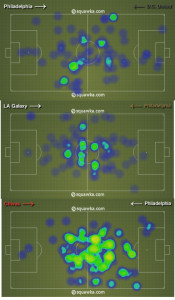
Edu rarely left the middle of the pitch, staying in front of Okugo and Williams while moving the ball from side to side
A lack of clarity as to how Edu, Nogueira, and Brian Carroll should play has been a running theme this season. While Nogueira has thrived in a thoroughly free role, Edu and Carroll have compensated by playing a hesitant second fiddle, both noncommittal offensively. Helping to isolate Erick Torres and rarely straying from home, Edu dominated the center of the pitch as the lone holding midfielder Saturday.
The major difference between this performance and recent disappointing showings was Edu’s central positioning, which underpinned a more conservative Union defensive shape.
Conservative, in this instance, means more structured. Too often this season, the Union have fallen prey to the same trap as the junior chess player: Mistaking any aggression for useful aggression.
The clearest example comes from the recent loss to LA. Philadelphia played their typical high pressure system, with Nogueira joining the lone striker in pressuring the opponents deep in their own half. Numerous times, the pressure forced LA to play longer than they wanted, but the depth of the pressure meant there were either too many holes in midfield or there was too much space between the forwards and midfielders to start a counterattack. Simply put, it was a spacing issue. And in the second half, LA figured it out.
Compared to the first half, the Galaxy defenders were much less likely to boot the ball long. Instead, they pulled their midfield a bit deeper and passed around the Union’s high pressure, pulling Baggio Husidic inside to offer another outlet for the defense. The Union never adjusted, and once LA (or any team, for that matter) found a way past the high press, the Philly defense became so stretched covering the space behind the top three that the Galaxy’s creative players wandered through empty space enjoying the good life.
Let’s think of it another way: Just because Philly has the athletes to press all over the pitch, does that mean they should? Absolutely not. A compact defense is the starting point for a good attack because the first few passes after winning or recovering a ball are about finding someone in enough space to look up and carry the ball forward or pick out a pass that gets the defense scrambling.
Transitioning from D to O
A good attack looks like a spring, in that it starts from a compact, organized defense and expands out, creating space quickly so the defense has to make decisions on the fly. The trick is to expand the attack in concert with ball movement. This is where the Union have looked unpracticed and unprepared all season. Again, the Los Angeles game offers a teachable half.
In the first half, high pressure forced LA to play longer than they wanted, resulting in a ton of loose balls in the middle of the pitch. Edu and Carroll gobbled up those balls and had nowhere to go. The team was too spread out to find a simple first pass into space to create time for a playmaker.
Expanding the attack as the ball moves means you cannot skip stages. Stage one of an attack involves winning the ball and moving it to space so a player has enough time to look up and pick out a pass that opens a team up. Stage two is movement off of that pass that takes advantage of a scrambling, out-of-shape defense.
The Union often skip stage one, going straight to the space-expanding movement. Think of the ball being won in midfield, then immediately seeing Danny Cruz and Sebastien Le Toux take off upfield. It’s somewhat similar to running long-developing pass plays against a blitz in American football: Even if those deep runs do stretch the defense, by the time Cruz and company check back, the ball-carrier has been closed down.
If anything can be gleaned from the Chivas match, it may be the need to retain a single defensive midfielder going forward. Not only does Maurice Edu appear much more comfortable in a simpler, win-the-ball-pass-the-ball role, but the double-deep midfield has invited more pressure than it has relieved. If Edu is to remain in midfield, clarifying his role is the first step in figuring out how to more effectively use Vincent Nogueira and Cristian Maidana.
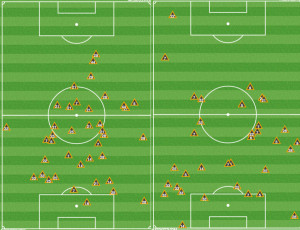
The Union picked up many more loose balls in the middle in the first half (L) compared to the second against LA.
The win over Kansas City is more instructive when examining how to improve the transition issue. In that match, Amobi Okugo’s ability to play out of tight spaces and stay close to Nogueira was the key that allowed the Union to quickly move from defense to attack. Okugo and Nogueira were able to get out of trouble, find a pass into space, then move to that space and find time to look up. The quick passes out of pressure made the vertical running by the rest of the offense more useful, since there was finally enough time to look up and use the space left behind.
Can the Union put it all together going forward?
It depends. What did the coaching staff learn from the trip out west?
Failure is often a better teacher than success, so looking to the Chivas win for answers may be a less useful exercise than examining why it all fell apart against LA (and New England before that). However, it is tempting to focus on the positives when things are going poorly.
If the Union simply think that trading a defensive midfielder for Fred is the answer, they will be taking the wrong lessons from an instructive road trip. Good players are better with more time on the ball. Chivas gave time to Maidana, Nogueira, and anyone else that wanted it. LA was less accommodating. The path to the playoffs is like trailblazing, space needs to be created in order to move forward. Unlike Chivas, the good teams won’t just hand it out.
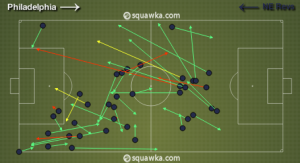
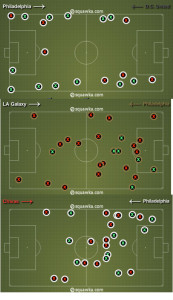
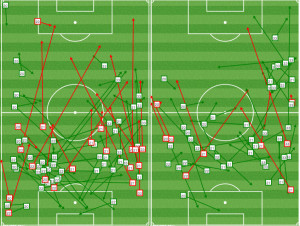
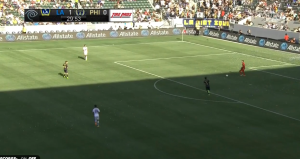
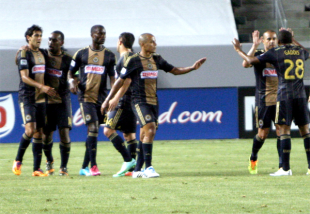

I think the bottom line to every single one of these tactical articles is always, “Why is Carrol playing?”
And its starting to get old because we suck and are one of the worst teams in the league.
Agreed. If the club is really looking to progress, than #7 should not be in the game plan. He has shown what he is and that is a very limited defender. He isn’t awful but he has shown that he does little to promote cohesive, positive play. His touch, passing and overall vision are very poor and limit the club. Not to mention it forces Hackworth to shuffle players, in order to fit Carroll. Okugo is better. Edu is better. Noguiera is better. Why is Carroll even a thought?
A thousand times this.
I think its less that Carroll specifically is the problem and more that running two defensive-minded midfielders is the problem.
And of course if we’re only running one defensive midfielder, Carroll probably isn’t the best one we have at this point.
The issue is more one of continually forcing guys to play in ways that don’t use their skills than it is an issue of poor play from Carroll.
I disagree. I think that Carroll has become a problem. Nothing against the man but he, and his skill sets no longer fit the club. A two DM set of Okugo/Noguiera has shown much more productivity that Carroll/Anyone. Edu/Okugo would be another option. Carroll’s play limits his fellow DM, due to drifting wide and very poor passing. His tackling is subpar, as well. Getting in the way is Brian Carroll’s strength. Unfortunately, he is getting in the way of his clubs progress and that can’t remain. Hackworth will live and die by how he handles the Carroll dilemma.
.
Carroll could be useful as a sub. Lahoud is just as good of an option. I would transfer Carroll to a club that could use his game.
I think labeling Nogueira as a DM is a problem. He’s not. For me, that deep 2 CM duo should be Nogueira + a DM. Right now the Union have 3 guys for that 1 role. I do not think Okugo/ Edu works because it is still too defensive with Nogueira as the “attacking” member of the trio.
I meant his field position. He tends to operate deep, in the same place on the pitch as Carroll. I see Noguiera as a deep lying box-to-box playmaker.
.
Playing Carroll with him would make Vincent’s head explode or, at the very least, make him more disenchanted with his current club.
.
I think that Okugo/Edu would develop, with Amobi stepping up to more of a playmakers role. Personally, I go Okugo/Noguiera.
Okugo/Edu’s effectiveness would hinge on Noguiera being able to play further up the pitch.
I agree. If a generalization can be made it is that Edu and Carroll play the same position and Edu should play. The quality of Nogueira is that he hardly loses the ball and completes most of his passes, which makes him ideal to be one of the transition players. Chaco also helps with this a great deal. what Fred showed is that you can benefit from having a 3rd MF who can keep and pass the ball and get into the box. If anything Carroll is better at passing the ball than Edu but does not cover as much ground and is not as imposing defensively.
I don’t think that is true. Carroll is efficient in the simplest way, which is to say sideways and backwards. Carroll is not a better passer of the ball. He just tends to default towards the safe pass more frequently. If there is one spot at DM, it should be Edu’s (or Okugo’s)
Exactly. Stats are only as good as the perspective you apply to them. If Carroll has options upfield but decides to square a ball to the fullback rather than penetrate the opponent’s midfield bank, that completed pass might be somewhat empty. Not that a simple possession pass isn’t useful at times, but that’s why we dig through the video.
…
That’s why I feel Opta stats are less useful than charting off the video. I still feel like it’s difficult to cultivate the raw data effectively. Whereas watching the tape gives you a clear snapshot of the moment.
@Earl – I agree with you up to a point. Bigger datasets (which are few and far between for soccer at this point) can usefully identify trends in how players pass, particularly when divided up by game state (tied, down a goal, etc). So while watching video is always going to give you the most direct access, it can also fool you. One spectacular play can trump a game full of bad decisions, and it’s hard for people to stay emotionally uninvolved enough to weigh the evidence well. Aggregating stats can be more useful because we want to know, Did he have a role to play? If he’s playing it well, what should we see in his passing charts, in his tackling charts, and so on. And then: Do we actually see those things?
that’s what the second sentence says. the last sentence’s point is that Edu gives the ball away, a lot. I have not analyzed opta stats, that’s just my recollection. if the priority is penetration over possession, I would agree carroll tends to play safe, but I don’t notice Edu playing too many risky passes. in general, i still see a lot of giveaways by Edu that are either poor decisions or lack of technique. I’d be curious to know whether the stats bear that out.
The stats do not support what you are saying. Edu is an efficient passer. His decision making pushing the ball forward is suspect, but to say that they lack technique is inaccurate. I believe he’s feeling the pressure and trying to push balls forward even when the spaces are tiny, which leads to turnovers. He and Carroll are actually fairly similar in this respect. The speed of play, ground covered, and strength are all on Edu’s side though.
based only on watching all of the games, Edu gives the ball away quite a bit when he is not under intense pressure. If not technique then lack of focus. I guess my issue is that he is the team’s highest paid DP, which raises expectations.. That is more of a FO issue since that slot should go to a goal scorer or creator.
Good write-up, Adam. Reading this, I couldn’t help, but think about what all of the Portland players said after the opening match. To a man, they said that they were surprised how open & aggressive that the Union had been as they thought that the U was going to pack it in and play on the counter. Clearly, Portland had a difficult time in adjusting their tactics to deal with this surprise move by Hackworth.
–
Jumping to the next match in the home opener vs. a struggling NE side which had conceded four at Houston the previous week. The Union dominated possession and play in the 1st half while NE sat back. However, at half time, Heaps made some adjustments with NE pressing more and the run of play totally shifted with the Union unable to keep the ball. Luckily, we were able to escape with a win, but I felt like the template had been set in how to play versus the Union. Compress the space and make them play direct rather than building with shorter passes.
I agree with this article. It takes me a long time to give up on something, but my doubts about the coaching staff are deep-seated enough at this point that it would take me a lot to believe a coaching change isn’t going to be necessary to change our fortunes.
I was ALMOST hoping for a big loss against Chivas to force Nick Sak’s hand before the world cup break (although I found I couldn’t hold onto that while actually watching the game).
I’m pretty sure this staff isn’t going to deliver more than mediocrity at this point, and at the same time, I’m pretty sure that Sak won’t make a change if there is any possible excuse not to. Rather than make me happy, the Chivas win just seems to be that excuse.
I agree with this 100%. We have too much individual talent to be doing this poorly. I really like this coaching staff as people but I don’t think we will ever be a playoff team let alone a MLS Cup-challenging team with this staff. I fear the Chivas win just bought Hackworth and co a few more weeks on the job which would be a waste at this point.
We should gut the house!
This article is an example of what most people would call analysis. It should be immediately forwarded to Hackworth’s desk.
.
It is painfully obvious that Hack doesn’t even see the issues raised in this article.
.
If it wasn’t clear already this is a fantastic article.
The Unions problem is almost always a spacing issue whether on offense, in transition or pressing defense- If you press you press as a unit and too often I see 2 players pressing but the remainder of team not properly deploying themselves to shut off the accesses of escape- which then has their underbelly exposed. Either the IQ is not there by the players or the ‘system’ is not being properly taught. I am inclined to believe it is a coaching failure. Defense is the one area of a team that does not take technical expertise. It takes complete tactical understanding and discipline as demonstrated through repeated practice and video tape and expectation and demanding of perfection. To me there is a lacksidasical culture amongst this team and you can’t effectively play defense in the style they hope to with that mindset. Just park the bus.
Based on post match quotes, what Coach learned in LA is that Fred is a wily vet who started because of BC’s hammy. Unfortunately.
All analysis posts at this point should just be a link to Tannenwald’s clip from Philly Soccer Show podcast in which he cites conversations w/ MLS people @ the US v TUR game: “Hackworth is in over his head and I’m surprised he’s still there.”
We’ve all known this for a while, but to hear MLS “people” say it out loud speaks volumes.